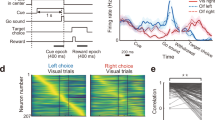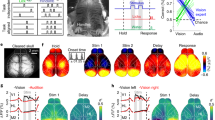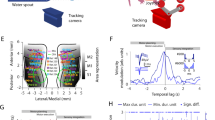Abstract
Selecting and planning actions recruits neurons across many areas of the brain, but how ensembles of neurons work together to make decisions is unknown. Temporally coherent neural activity may provide a mechanism by which neurons coordinate their activity to make decisions. If so, neurons that are part of coherent ensembles may predict movement choices before other ensembles of neurons. We recorded neuronal activity in the lateral and medial banks of the intraparietal sulcus (IPS) of the posterior parietal cortex while monkeys made choices about where to look and reach. We decoded the activity to predict the choices. Ensembles of neurons that displayed coherent patterns of spiking activity extending across the IPS—'dual-coherent' ensembles—predicted movement choices substantially earlier than other neuronal ensembles. We propose that dual-coherent spike timing reflects interactions between groups of neurons that are important to decisions.
This is a preview of subscription content, access via your institution
Access options
Subscribe to this journal
Receive 12 print issues and online access
$209.00 per year
only $17.42 per issue
Buy this article
- Purchase on Springer Link
- Instant access to full article PDF
Prices may be subject to local taxes which are calculated during checkout








Similar content being viewed by others
References
Lewis, J.W. & Van Essen, D.C. Corticocortical connections of visual, sensorimotor, and multimodal processing areas in the parietal lobe of the macaque monkey. J. Comp. Neurol. 428, 112–137 (2000).
Johnson, P.B., Ferraina, S., Bianchi, L. & Caminiti, R. Cortical networks for visual reaching: physiological and anatomical organization of frontal and parietal lobe arm regions. Cereb. Cortex 6, 102–119 (1996).
Van Der Werf, J., Jensen, O., Fries, P. & Medendorp, W.P. Neuronal synchronization in human posterior parietal cortex during reach planning. J. Neurosci. 30, 1402–1412 (2010).
Konen, C.S., Mruczek, R.E.B., Montoya, J.L. & Kastner, S. Functional organization of human posterior parietal cortex: grasping- and reaching-related activations relative to topographically organized cortex. J. Neurophysiol. 109, 2897–2908 (2013).
Marconi, B. et al. Eye-hand coordination during reaching. I. Anatomical relationships between parietal and frontal cortex. Cereb. Cortex 11, 513–527 (2001).
Rozzi, S. et al. Cortical connections of the inferior parietal cortical convexity of the macaque monkey. Cereb. Cortex 16, 1389–1417 (2006).
Cavada, C. & Goldman-Rakic, P.S. Posterior parietal cortex in rhesus monkey: II. Evidence for segregated corticocortical networks linking sensory and limbic areas with the frontal lobe. J. Comp. Neurol. 287, 422–445 (1989).
Cavada, C. & Goldman-Rakic, P.S. Topographic segregation of corticostriatal projections from posterior parietal subdivisions in the macaque monkey. Neuroscience 42, 683–696 (1991).
Schmahmann, J.D. & Pandya, D.N. Anatomical investigation of projections from thalamus to posterior parietal cortex in the rhesus monkey: a WGA-HRP and fluorescent tracer study. J. Comp. Neurol. 295, 299–326 (1990).
Prevosto, V., Graf, W. & Ugolini, G. Cerebellar inputs to intraparietal cortex areas LIP and MIP: functional frameworks for adaptive control of eye movements, reaching, and arm/eye/head movement coordination. Cereb. Cortex 20, 214–228 (2010).
Colby, C.L. Action-oriented spatial reference frames in cortex. Neuron 20, 15–24 (1998).
Snyder, L.H., Batista, A.P. & Andersen, R.A. Coding of intention in the posterior parietal cortex. Nature 386, 167–170 (1997).
Roitman, J.D. & Shadlen, M.N. Response of neurons in the lateral intraparietal area during a combined visual discrimination reaction time task. J. Neurosci. 22, 9475–9489 (2002).
Sugrue, L.P., Corrado, G.S. & Newsome, W. T. Matching behavior and the representation of value in the parietal cortex. Science 304, 1782–1787 (2004).
Platt, M.L. & Glimcher, P.W. Neural correlates of decision variables in parietal cortex. Nature 400, 233–238 (1999).
Kubanek, J. & Snyder, L.H. Reward-based decision signals in parietal cortex are partially embodied. J. Neurosci. 35, 4869–4881 (2015).
Liu, Y., Yttri, E.A. & Snyder, L.H. Intention and attention: different functional roles for LIPd and LIPv. Nat. Neurosci. 13, 495–500 (2010).
Wilke, M., Kagan, I. & Andersen, R.A. Functional imaging reveals rapid reorganization of cortical activity after parietal inactivation in monkeys. Proc. Natl. Acad. Sci. USA 109, 8274–8279 (2012).
Hwang, E.J., Hauschild, M., Wilke, M. & Andersen, R.A. Inactivation of the parietal reach region causes optic ataxia, impairing reaches but not saccades. Neuron 76, 1021–1029 (2012).
Kubanek, J., Li, J.M. & Snyder, L.H. Motor role of parietal cortex in a monkey model of hemispatial neglect. Proc. Natl. Acad. Sci. USA 112, E2067–E2072 (2015).
Hagler, D.J. Jr., Riecke, L. & Sereno, M.I. Parietal and superior frontal visuospatial maps activated by pointing and saccades. Neuroimage 35, 1562–1577 (2007).
Dean, H.L., Hagan, M.A. & Pesaran, B. Only coherent spiking in posterior parietal cortex coordinates looking and reaching. Neuron 73, 829–841 (2012).
Banerjee, A., Dean, H.L. & Pesaran, B. A likelihood method for computing selection times in spiking and local field potential activity. J. Neurophysiol. 104, 3705–3720 (2010).
Womelsdorf, T. et al. Modulation of neuronal interactions through neuronal synchronization. Science 316, 1609–1612 (2007).
Wang, X.-J. Neurophysiological and computational principles of cortical rhythms in cognition. Physiol. Rev. 90, 1195–1268 (2010).
Haegens, S. et al. Beta oscillations in the monkey sensorimotor network reflect somatosensory decision making. Proc. Natl. Acad. Sci. USA 108, 10708–10713 (2011).
Pesaran, B., Nelson, M.J. & Andersen, R.A. Free choice activates a decision circuit between frontal and parietal cortex. Nature 453, 406–409 (2008).
Donner, T.H., Siegel, M., Fries, P. & Engel, A.K. Buildup of choice-predictive activity in human motor cortex during perceptual decision making. Curr. Biol. 19, 1581–1585 (2009).
Pesaran, B., Pezaris, J.S., Sahani, M., Mitra, P.P. & Andersen, R.A. Temporal structure in neuronal activity during working memory in macaque parietal cortex. Nat. Neurosci. 5, 805–811 (2002).
Salazar, R.F., Dotson, N.M., Bressler, S.L. & Gray, C.M. Content-specific fronto-parietal synchronization during visual working memory. Science 338, 1097–1100 (2012).
Scherberger, H., Jarvis, M.R. & Andersen, R.A. Cortical local field potential encodes movement intentions in the posterior parietal cortex. Neuron 46, 347–354 (2005).
Hagan, M.A., Dean, H.L. & Pesaran, B. Spike-field activity in parietal area LIP during coordinated reach and saccade movements. J. Neurophysiol. 107, 1275–1290 (2012).
Bosman, C.A. et al. Attentional stimulus selection through selective synchronization between monkey visual areas. Neuron 75, 875–888 (2012).
Gregoriou, G.G., Gotts, S.J., Zhou, H. & Desimone, R. High-frequency, long-range coupling between prefrontal and visual cortex during attention. Science 324, 1207–1210 (2009).
Mitchell, J.F., Sundberg, K.A. & Reynolds, J.H. Differential attention-dependent response modulation across cell classes in macaque visual area V4. Neuron 55, 131–141 (2007).
Sailer, U., Eggert, T. & Straube, A. Implications of distracter effects for the organization of eye movements, hand movements, and perception. Prog. Brain Res. 140, 341–348 (2002).
de Lafuente, V., Jazayeri, M. & Shadlen, M.N. Representation of accumulating evidence for a decision in two parietal areas. J. Neurosci. 35, 4306–4318 (2015).
Horstmann, A. & Hoffmann, K.-P. Target selection in eye-hand coordination: do we reach to where we look or do we look to where we reach? Exp. Brain Res. 167, 187–195 (2005).
Vercher, J.L. & Gauthier, G.M. Oculo-manual coordination control: ocular and manual tracking of visual targets with delayed visual feedback of the hand motion. Exp. Brain Res. 90, 599–609 (1992).
Bastos, A.M. et al. Visual areas exert feedforward and feedback influences through distinct frequency channels. Neuron 85, 390–401 (2015).
Markowitz, D.A., Shewcraft, R.A., Wong, Y.T. & Pesaran, B. Competition for visual selection in the oculomotor system. J. Neurosci. 31, 9298–9306 (2011).
von Stein, A. & Sarnthein, J. Different frequencies for different scales of cortical integration: from local gamma to long range alpha/theta synchronization. Int. J. Psychophysiol. 38, 301–313 (2000).
Gould, I.C., Nobre, A.C., Wyart, V. & Rushworth, M.F.S. Effects of decision variables and intraparietal stimulation on sensorimotor oscillatory activity in the human brain. J. Neurosci. 32, 13805–13818 (2012).
Gregoriou, G.G., Gotts, S.J. & Desimone, R. Cell-type-specific synchronization of neural activity in FEF with V4 during attention. Neuron 73, 581–594 (2012).
Cardin, J.A. et al. Driving fast-spiking cells induces gamma rhythm and controls sensory responses. Nature 459, 663–667 (2009).
Banerjee, A., Dean, H.L. & Pesaran, B. Parametric models to relate spike train and LFP dynamics with neural information processing. Front. Comput. Neurosci. 6, 51 (2012).
Waldert, S., Lemon, R.N. & Kraskov, A. Influence of spiking activity on cortical local field potentials. J. Physiol. (Lond.) 591, 5291–5303 (2013).
Mitra, P.P. & Pesaran, B. Analysis of dynamic brain imaging data. Biophys. J. 76, 691–708 (1999).
Jarvis, M.R. & Mitra, P.P. Sampling properties of the spectrum and coherency of sequences of action potentials. Neural Comput. 13, 717–749 (2001).
Maris, E., Schoffelen, J.-M. & Fries, P. Nonparametric statistical testing of coherence differences. J. Neurosci. Methods 163, 161–175 (2007).
Acknowledgements
This work was supported, in part, by US National Institutes of Health (NIH) grant R01-MH087882 as part of the National Science Foundation (NSF)/NIH Collaborative Research in Computational Neuroscience Program, NIH R01-EY024067, NSF CAREER Award BCS-0955701, and the SUBNETS program sponsored by the US Defense Advanced Research Projects Agency Biological Technologies Office.
Author information
Authors and Affiliations
Contributions
Y.T.W., B.P. and N.D.D. designed the experiments. Y.T.W., B.P., M.M.F. and Y.N. performed the experiments. Y.T.W., B.P., M.M.F., Y.N. and N.D.D. analyzed the data. Y.T.W., B.P. and N.D.D. wrote the manuscript.
Corresponding author
Ethics declarations
Competing interests
The authors declare no competing financial interests.
Integrated supplementary information
Supplementary Figure 1 Controls for timing of choice information
a) Area under the curve values for a ROC analysis on population average firing rates for movements into and out of the RF when 5 neuron averages are used. Fewer neurons were used due to the smaller population size of long-range coherent neurons. 95% confidence intervals are shown. b) P-values for a Wilcoxon rank sum test comparing the AUC values for each group against 0.5. c) STs for three different populations of dual coherent (solid), local-only coherent (solid-gray) and not coherent (dashed) neurons. Error bars indicate standard error of the mean. Neuron–pools of size 11 were used. d) Individual monkey STs for dual coherent neurons. For reference, the local-only and not coherent neuron STs are presented. (Monkey C: Dual ST =188.7 ± 3 ms. Dual vs Local-only: p = 5.5e-10. Dual vs Not: p = 7.5e-10; Monkey R: Dual ST: 210.6 ± 1 ms. Dual vs Local-only: p = 3.7e-10. Dual vs Not: p = 3.7e-10. Rank sum test).
Supplementary Figure 2 Choice timing across the medial and lateral banks of the IPS
a) Choice selection times for the lateral bank (solid) and medial bank (dashed). Selection times decrease for the choice prediction method as more cells are added. For the lateral bank eight trial averages were used in the 47 cell analysis due to insufficient trials (circle). b) Same as c) for increasing trial averages. d) Probability of a correct classification for decoding in the lateral bank (solid) and medial bank (dashed). Mean ± SEM are shown.
Supplementary Figure 3 Locations of neurons classified by coherence
Recording locations along the IPS separated into different subpopulations defined by coherence. The number of neurons for each population was expected given the sample in the database, with the exception of the long-range-only population (Total number of MIP neurons in database 42/72=58%. The proportion of locally coherent population MIP neurons was not significantly different from the whole proportion of the population (30/53 57%, p = 0.11 Binomial test). The same was true for the complement of LIP neurons (p=0.10). However, the proportion of long-range coherent population MIP neurons was significantly different from the proportion of the population (27/36, 75% p = 0.01 Binomial test).
Supplementary Figure 4 Firing rates across neuronal ensembles separated by coherence
a) Population average firing rate for the four populations of neurons defined according to the presence of local and long-range coherence. b) Population average firing rate between populations after the spike trains were decimated so that the mean firing rates is equal during the baseline epoch. Firing rate averaged over trials when the target in the response field is chosen (solid). Firing rate averaged over trials when the target out of the response field is chosen (dashed). The standard error of the mean of the firing rates (gray shaded).
Supplementary Figure 5 Comparing the timing of choice information in ensembles of neurons with high and low firing rates
STs for all neurons when separated by the firing rate in the a) baseline period and b) the delay period. Neuron–pools of size 11 were used. The ST for the dual coherent population is shown for comparison. Mean ± SEM are shown.
Supplementary Figure 6 Average firing rates for neurons separated based in firing rate measures
Average firing rates for populations defined by a) baseline and b) delay period firing rates as well as by c) rate correlations. The SEM is shown in grey.
Supplementary Figure 7 Center-out firing rates for neural ensembles
In vs out of the RF firing rate differences for a center-out task for each population. While firing rates for dual coherent neurons tended to have larger differences in firing rate, these differences were not significant (Dual: 45.1 ± 14.2 spikes/s (mean ± s.e.m); Local-only: 24.3 ± 8.0 spikes/s; Long-range-only: 24.1 ± 11.3 spikes/s; Not: 14.9 ± 9.2 spikes/s. p > 0.05 all comparisons; Rank sum test).
Supplementary Figure 8 Firing rate controls for the timing of choice information across neuronal ensembles
a) Difference in decimated firing rate for movements into and out of the RF for different groups of neurons. Mean ± S.E.M. are shown. b) P-values for a Wilcoxon rank sum test comparing decimated firing rates into and out of the RF for each group. Arrows indicate the first point the statistical tests fell below 0.05 for three consecutive bins and remained significant. c) Area under the curve values for a ROC analysis on population decimated average firing rates for movements into and out of the RF. Mean ± 95% confidence intervals are shown. The symbols above the AUC lines indicate significant differences between each pair of lines using a FDR corrected Wilcoxon rank sum test. d) P-values for a Wilcoxon rank sum test comparing the AUC values for each group against 0.5. Arrows indicate the first point the statistical tests fell below 0.05 for three consecutive bins and remained significant. e) STs calculated with decimated firing rates. f) STs calculated with firing rates for populations of neurons classified via spike-field coherence using decimated firing rates.
Supplementary Figure 9 Comparison of spike-field coherence when measured on the same and different electrodes
Baseline local spike-field coherence averaged across 27 same-electrode pairs (red) and 45 different-electrode spike-field pairs (black). 95% confidence interval (shaded). At 20 Hz same-electrode: 0.13 ± 0.03, different-electrode: 0.14 ± 0.02, p = 0.47 Rank sum test.
Supplementary Figure 10 Spike widths for neurons separated into neuronal ensembles
a) Scatter plot of the width of the spike waveforms for the dual coherent (red cross), not coherent (black circle), local only coherent (blue cross) and long-range only coherent (green box) neurons. Half-amplitude duration (vertical axis) and trough-to-peak time (horizontal axis). b) Histogram of trough-to-peak times for dual coherent (red), local-only coherent (blue), not coherent (black) and long-range only coherent (green) neurons.
Supplementary information
Supplementary Text and Figures
Supplementary Figures 1–10 (PDF 1597 kb)
Rights and permissions
About this article
Cite this article
Wong, Y., Fabiszak, M., Novikov, Y. et al. Coherent neuronal ensembles are rapidly recruited when making a look-reach decision. Nat Neurosci 19, 327–334 (2016). https://doi.org/10.1038/nn.4210
Received:
Accepted:
Published:
Issue Date:
DOI: https://doi.org/10.1038/nn.4210
This article is cited by
-
Perceptual decisions interfere more with eye movements than with reach movements
Communications Biology (2023)
-
Modulation of inhibitory communication coordinates looking and reaching
Nature (2022)
-
Sensory representation of visual stimuli in the coupling of low-frequency phase to spike times
Brain Structure and Function (2022)
-
Marmosets: a promising model for probing the neural mechanisms underlying complex visual networks such as the frontal–parietal network
Brain Structure and Function (2021)
-
Specialized medial prefrontal–amygdala coordination in other-regarding decision preference
Nature Neuroscience (2020)



